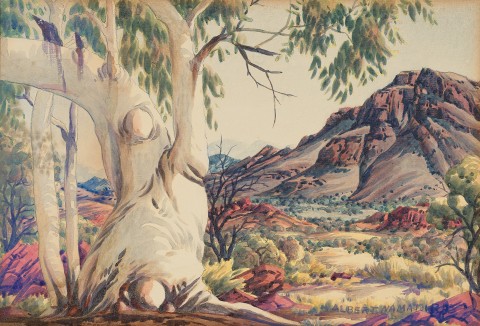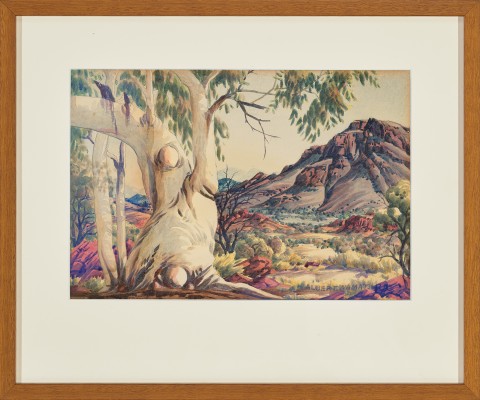GHOST GUM, CENTRAL AUSTRALIA
ALBERT NAMATJIRA
watercolour on paper
23.0 x 34.0 cm
signed lower right: ALBERT NAMATJIRA
Private collection, Perth
Thence by descent
Private collection, Perth
Alice Springs Country, c.1955 – 59, watercolour on paper, 37.5 x 53.0 cm, private collection, illus. in French, A. (ed.), Seeing the Centre; The Art of Albert Namatjira 1902 – 1959, National Gallery of Australia, Canberra, 2002, p. 143
North Ranges Looking South, c.1950s, watercolour on paper, 30.5 x 41.0 cm, in the collection of the Art Gallery of New South Wales, Sydney
‘Albert Namatjira was a phenomenon… a patient and observant man… who became a watercolourist of real distinction… who recorded what was familiar to him not only as something of sublime beauty, but as a repository of beliefs, laws and legends.’1
A household name by the 1950s, Albert Namatjira set the foundations for the Indigenous art movement that emerged thirty years later and still flourishes today. ‘In skillfully adopting the methods and materials of Western landscape painting he challenged the relegation of Aboriginal art to the realm of archaeology and ethnography.’2 His bright watercolours of central Australia contained an unprecedented richness, and his depiction of the vivid and exuberant colours of Arrente country transported a mythical and predominantly unknown world into the lounge rooms of White Australians living in cities that hugged the coastal fringe.
Painted in the final years of the artist’s life, and replete with the artist’s recurring motifs, Ghost Gum, Central Australia, epitomises Namatjira’s finest work. Located in the foreground, a majestic ghost gum, (Eucalyptus papuana), known as ilwempe to the Western Arrernte, is used as an animated object to frame the carefully controlled viewpoint from which the artist directs the viewer to the distant blue peaks through the intervening slopes in the middle distance. Namatjira’s familiarity with this country is evident in these views where ‘trees, peaks and monoliths provide a rich range of possibilities and responses that arise from constantly re-engaging with the same subject.’3
Namatjira’s dramatic entry into the Australian art world was groundbreaking. Despite his personal vicissitudes, he not only inspired his own and subsequent generations of Aboriginal people and artists across Australia through his art, but he also sought to educate White Australians about the spiritual link between Indigenous people and land. As Brenda Croft contends, the artist’s gift to Indigenous and non-Indigenous people is ‘more than the sum parts of watercolour paints on paper. It is an essence that resides in the strength of Namatjira’s work – his courage, his sorrow, his spirituality… where the enduring influence of this one man upon the entire indigenous arts and culture industry continues to be felt.’4
1. Lynn, E., ‘Introduction’ in Byrnes, M., Albert Namatjira, Araluen Art Centre, Alice Springs 1984, p. 2
2. Watson, K., ‘Poetic Justice: an overview of Indigenous Art’, in Perkins, H., One Sun, One Moon: Aboriginal Art in Australia, Art Gallery of New South Wales, Sydney, 2007, p. 20
3. French, A., Seeing the Centre: The Art of Albert Namatjira 1902 – 1959, National Gallery of Australia, Canberra, 2002, p. 97
4. Croft, B., ‘Albert’s Gift’, in French, A., Seeing the Centre: The Art of Albert Namatjira, 1902 – 1959, National Gallery of Australia, Canberra, 2002, p. 148
CRISPIN GUTTERIDGE


